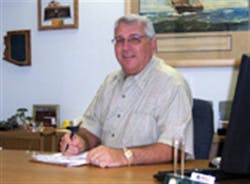If anybody knows OTR tires, it's Al Chicago. The Purcell Tire & Rubber Co. senior vice president has been working with OTR tires since 1964, when he was hired in as a tire changer at Western States Tire in Phoenix, Ariz. He rose through the ranks, becoming a salesman and then a store manager before being promoted to vice president of the company in 1978.
Potosi, Mo.-based Purcell Tire bought Western States in 1981 and Chicago was elevated to his current position in the early 1990s. He now runs Purcell Tire's Western Division, plus its operation in Mexico. He also serves on Goodyear Tire & Rubber Co. and Michelin North America Inc.'s OTR tire dealer councils.
Commercial Tire Dealer recently caught up with Chicago to get his take on the North American OTR tire market, which has been depressed for a number of years. His candid report might surprise you.
CTD: What was the North American OTR tire market like in 2003?
Chicago: In some parts of the country like the east, it was flat. In other areas, it was good. The western part of the country and the Midwest were better than the eastern parts. It wasn't an excellent year, but a good year overall.
CTD: How close is the health of the mining industry linked to the condition of the OTR tire market?
Chicago: In some states, the (connection) is really big. Take Nevada, Arizona and Utah, for example -- those states are huge in mining. When mining is floundering, it hurts the OTR tire market because of the amount of earthmover business in those states.
CTD: Mineral prices have been down for several years. In fact, copper and lead reached all-time lows in early 2003. What are mineral prices like now?
Chicago: Mineral prices have gone nuts. Copper is up to $1.09 a pound (at press time) from 60 cents a year ago. Gold during the first part of 2003 was in the $300-plus dollar range; right now it's in the $400-plus range. Aggregate prices have not slowed down. As long as there's construction, (companies) will need aggregate for concrete buildings and such.
CTD: Why have mineral prices shot up?
Chicago: Inventories. A year ago, mines cut back and some closed, so inventories got lower. Now inventories are turning around. There's new demand in the Southwest, where there's a lot of growth. Copper is used in almost everything -- houses, cars, airplanes, electronics, everything.
The outlook is good for 2004.
CTD: How much of an impact are low-cost imports having on the domestic market and what segments are being hit the hardest?
Chicago: They've had an impact on smaller OTR tires like the 15.5x25, the 17.5x25 and the 20.5x25 sizes. They also hurt OTR retreading; these tires are so cheap that a lot of customers would rather buy a new tire than a retread.
Customers who don't track the performance of their tires by hours or miles don't realize that if they put on a quality tire, it will run twice as long as a cheap one.
CTD: Have domestic OTR tire manufacturers responded effectively to the continuing influx of offshore product?
Chicago: Everybody is trying to respond -- some by price, and that's not good because all the margins go down for everyone. The manufacturers can't make enough money and the dealers can't make enough money.
CTD: In 2002, radials comprised 53% of the domestic replacement OTR tire market. Do you foresee a time when radials will make up 100% of the market or will there always be a spot for bias OTR tires?
Chicago: Radials will continue to grow. Every year they'll take another piece (of the market) because of everyone getting into it. But I don't know if bias will go away 100%. There's still a market for bias OTR tires in certain applications, like around dock areas. Some small mining and farming operations are using bias tires.
CTD: From your perspective as a long-time OTR tire dealer, how has the market evolved? What are the most significant changes you've seen over the past 20 years?
Chicago: Radialization has been one of the biggest changes. But it's a Catch-22; you want to take care of your customer and give them the best thing, but in some cases you may not sell him another tire for a year or two compared to two or three bias tires a year in some applications.
Tires have gotten bigger than I ever dreamed they'd get. I thought the 51-inch would be the biggest and now we have the 63-inch. And there may be bigger sizes coming out, going from 63 inches to possibly 69 or even 72 inches for the big 400-ton trucks and loaders!
OTR tire dealers also are getting bigger because they're buying out smaller dealers.
CTD: Has there been a lot of consolidation among independent OTR tire dealers?
Chicago: Yes. Smaller dealerships have not been able to compete. The cost of doing business today makes it very, very difficult for smaller dealers to exist.
CTD: What will tire dealers have to do in order to stay competitive as the market continues to evolve?
Chicago: The key thing is to stay close to your customers by calling on them and not taking them for granted. And have the best service; service sells tires. And tied in with that is having a good tracking system. Customers expect you to track tire performance for them from cradle to grave. You have to prove to them that your tires and your service are the best. You can't take anyone for granted anymore!



